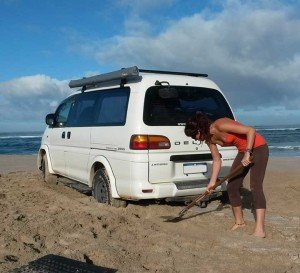A topic of conversation that often comes up when talking about off-road touring with fellow travellers is what 4WD and recovery equipment to bring with you on short and extended trips where you will be encountering a wide variety of terrain on the way to the next secluded camp spot.
We’re definitely not hard-core off 4WD enthusiasts. Actually, we avoid tracks that look too gnarly unless we are with other vehicles and we’re fairly confident in being able to make it through. That said, our Delica is a very capable 4WD vehicle, even when fully loaded, and we’ve rarely had to shy away from getting to our planned destination.
The main confidence booster is having your vehicle prepared for action, and having the knowledge and gear to help you get unstuck when the inevitable does happen!
I’ve used and owned a fair amount of 4WD and recovery gear over the years and I have found that the essentials will have you sorted in almost all situations, plus save a lot of space, weight and money.
12V portable air compressor
Hands down the most important piece of equipment you could have in any type of vehicle while touring and travelling – not just for 4WD vehicles!
Correct tyre pressure is essential to preventing getting bogged. Plus correct pressure will improve ride quality, handling, fuel economy and tyre wear when adjusted to road conditions accordingly.
This article goes into more detail about how to correctly adjust tyre pressure for different situations and is well worth a read.
Invest in a good quality compressor that has a high Litre per Minute (LPM) and pressure rating so you don’t have to stand around for half an hour waiting for your tyres to inflate.
We use and recommend:
Recovery tracks
I was sceptical about buying a pair of recovery tracks as they seemed to be fairly expensive and space consuming, and we had foam mats that we could use in the event of getting bogged.
However, the first time we did get properly bogged at a beach in South Australia, I quickly realised how useless cheap alternatives are; they simply didn’t help!
Long story short (I’ll save it for another day) we found out that a good set of recovery tracks are well worth the money and space, especially when they save you from a rising tide!
We use and recommend:(one pair) with a custom canvas protective cover
Exhaust jack
This was another piece of equipment that I was sceptical about that proved its worth when we were bogged to the axles in the face of a rising tide.
Simply put, a recovery jack paired with a set of recovery tracks is one of the fastest, safest and easiest ways to self-recover from a boggy situation.
We use and recommend:
Snatch strap
The biggest problem with a snatch strap is that you will need another vehicle to help pull you, or vice versa, out of a bog. Other issues include the safety aspect of using straps as they can fail spectacularly under pressure – resulting in potentially lethal recoil, especially when they are still incorrectly attached to a shackle or tow ball.
However, with the safe and correct use of snatch straps in mind, a strap that is in good condition, rated for the load and correctly used can be an effective way to get unstuck as a last resort when all other recovery attempts have failed. Always try to self-recover using your recovery tracks and exhaust jack first!
As our Delica doesn’t have proper rated recovery points, we also use a recovery hitch and shackle with our rear tow bar in the extremely rare event that we use a strap or are being winched. We also use a large beach towel as a dampener to prevent the slingshot factor in the potential situation of the strap failing.
We use and recommend:,
Long handle shovel

Simplicity defined! The humble shovel hasn’t really changed much over the years and that’s for good reason. It works and it works well.
A long handled shovel will allow you to get right under your vehicle and around the tyres to clear away sand and other debris.
An added bonus is that we use the shovel for purposes other than recoveries; including digging out fire pits and levelling the vehicle.
Look for a shovel with a long handle and reinforced collar. Ideally you’ll want a shovel that is sturdy but as light as possible to reduce fatigue after shovelling sand for hours.
We use and recommend: Square mouth post hole shovel – have a look at your local hardware store and pick the best one!
A final note for the dedicated
Of course, if you are really serious about 4WD adventures and plan to drive your vehicle through gnarly tracks, you will need a powerful, high quality winch, rated recovery points and a snatch block etc, plus the knowledge to properly use it all, to allow recovery in more extreme situations.
Personally, four-wheel-driving is a means to an end – that being I have a 4WD vehicle just in case the track to a nice camp site is a little boggy. I prefer to avoid difficult situations where possible and keep it simple, light and affordable with the essentials.







Leave A Comment